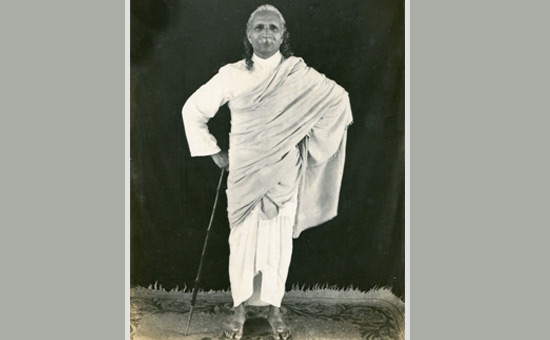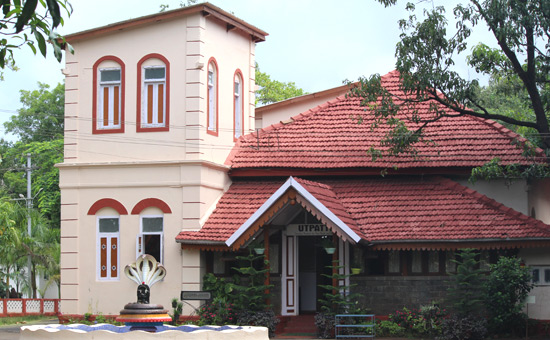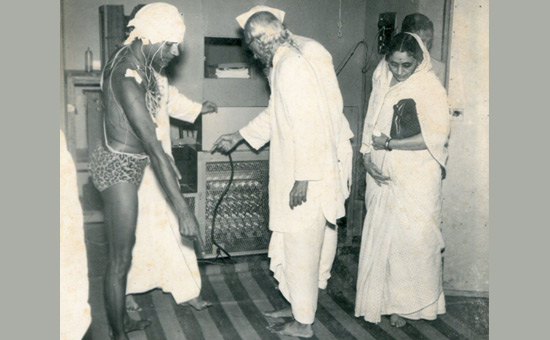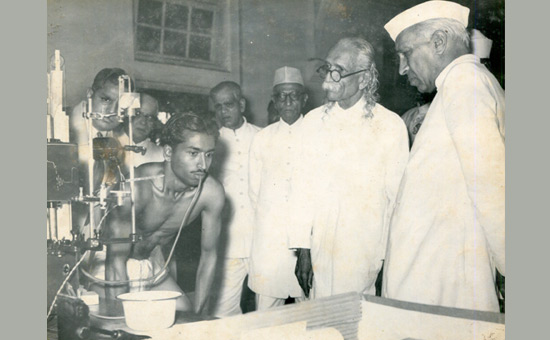- The Ministry of Ayush, Government of India is going to release a stamp in honour of Swami Kuvalayanandaji. This article, very briefly, tells you about his life and achievements.
In the modern history of Yoga, the honour of applying for the first time the Scientific Methodology to the ancient Indian traditional "Yogavidya" goes to Swami Kuvalayanandaji. Hence Swamiji is known as a pioneer scientist of Yoga or the father of Scientific Yogic Research Studies.
Swamiji was born on August 30 1883 in a village in Gujarat. His father was Shri Gánesha Laxmana Gune and mother Smt Saraswati. They named him Jagannatha. When Jagannatha was hardly fourteen
years old he lost his parents. At that time, he was studying probably in IV or
V standard. Subsequently Jagannatha went to Pune for further education and
joined Nutan Marathi Vidyalaya.
Sanskrit was one of Swamiji’s favourite subjects. He secured highest marks in matriculation in the year 1903 for which he was awarded the Prestigious Jagannatha Shankarsetha Scholarship.
This achievement
provided Swamiji an occasion to study Indian Literature, Spirituality, Poetics,
Drama, Puranas, Mahabharata, Ramayana etc. and laid the foundation for his
becoming a Poet, great Sanskrit Scholar and researcher in Yogic Literature
embodied in Sanskrit language.
After Matriculation Swamiji went to Baroda and joined Baroda College in 1904 for the B.A. course. It is during his early college life that Swamiji was influenced by great political personalities like Lokmanya Tilaka, such that he left college education to work actively for the cause of political and social awakening. This phenomenon brings forth Swamiji's patriotism and the love for his countrymen which further got manifested in the form of vows to be observed and the ideals to be sought after which he pursued throughout his life. These ideals, as put by D.G.Wakharkar are (Kaivalyadnama, 1948):
One, ‘To prepare the young generation for the service of the country.’ Two, ‘To master the Indian System of Physical Education and integrate it with general education.’ Three, ‘To bring together science and spiritual aspects of Yoga with modern Science. In order to materialize these ideals, he observed Brahmacharya throughout his life.’
With a view to
serve his country in the above envisaged way Swamiji realized the importance of
education so in 1907 rejoined Baroda College, Baroda and successfully passed
B.A. Examination in 1910 at the age of 27. During these years Swamiji received
training in the Indian System of Physical Culture including Yoga under the Guru
Raj-Ratna Prof. Manik rao of Baroda.
Under the guidance of Prof. Manik rao, Swamiji's patriotism and the zeal to work for the sake of educating Indian masses - ignorant, illiterate, superstitious and sick in spirit and body - received a concrete direction.
He realized that education can play an important role in reviving the Indian masses and thereafter Mother India (ICYHC 1975). In order to realize his ideals Swamiji selected, and aptly so, a teacher's career. He first joined Chimnabai High School, Baroda (1913- 1915) and later on the then famous Khandesh Education Society (K.E.S.) at Amalner, Maharashtra. Later he left it to establish Kaivalyadhama Ashrama at Lonavla in the year 1924. Swamiji transformed K.E.S. into the right platform for inculcating the spirit of National Education among the students.
During this period he also wrote patriotic, devotional songs in Sanskrit and Marathi languages. Besides being a scientist Swamiji was a Sanskrit scholar, educationalist, spiritual personality, poet who continued to write songs, sometimes recite them until late in his life. In a letter dated 29th September 1965, written to Prof. V.B.Ghanekar who translated Swamiji's books on Asana and Pranayama into Hindi, Swamiji says "In about a fortnight's time I shall be mailing your worthy father one or two songs of mine for his kind perusal and blessings."
Swamiji's fascination and delight in intense Sanskrit poetry is so intense that he assumed the name "Kuvalayananda" for himself which he used in his devotional songs in Sanskrit, "anandaya sadastu
me Kuvalayanandasya nandatmajah." Later on he became famous by this name in the field of Yoga too.
 Swami Kuvalayananda in his younger days.
Swami Kuvalayananda in his younger days.
Along with the teaching activities at K.E.S. Amalner Swamiji was practicing Yoga about which he himself writes: "At the end of 1918 my intensity about the practice of Yoga reached its climax. To receive initiation from Paramahansa Maharaj was my intent desire. (Gharote etc 1999)
His Holiness Paramahansa Shri Madhavadasji Maharaj, originally from Bengal, belonged to the tradition of Shri Gauranga Mahaprabhu and was a perfect spiritual personality who lived on the banks of Narmada at Malsar, near Baroda (Gujarat) after performing intense 'tapasya' in Kanakeshwar near Alibaug in Maharashtra. He was known also as 'Mirchibaba' as he lived only on green chilies and a little butter milk. The intense desire of Swamiji materialized towards the end of 1918 when he became a disciple of Paramahansaji. Swamiji was blessed by his Guru with Yogic training on Spiritual and Scientific lines.
Highlighting this aspect Dr. G. Rama Krishna observes, “Apart from the techniques of Yoga the pupil was also introduced to the intricacies of its meaning and efficacy. The rationalist in Gune could hardly have accepted anything without questioning persistently. As it happened, Madhavadas himself was not averse to any scrupulous analytical forays into Yoga because he did not consider it to be beyond all investigations. Gune and Madhavadas were made for each other in a way and found fulfillment in each other as time passed.” (Kaivalyadhama, 1999).
In those days Yoga
was shrouded in mystery and was beset with various blind beliefs, misgivings
and had hardly any appeal to the modern scientific mind. Swamiji had fully
realized about the infinite Yogic potentialities and its efficaciousness on
human body and mind, started investigating the effects of some of the yogic
practices on the human body by taking a few students in the laboratory of
Baroda Hospital years 1920-1921.
His subjective experience coupled with the excellent results of these scientific experiments convinced him that the age-old system of Yoga, if understood through the modern scientific experimental approach, would help greatly in the spiritual and material resurgence of human society. This became his life's mission. (ICYHC, 1992, p.31)
In 1920 the then
British Government de-recognized the National College of which Swamiji was the
Principal because of the fear that the nationalistic education imparted therein
would spread a feeling of revolt amongst the students against the brutal
British rule. Even under such circumstances Swamiji continued his experimental
studies of Yoga till 1923 while being associated with K.E.S. It is through
these studies Swamiji realized that modern science has come to a stage
sufficiently advanced to deal with the problems related to Yoga and that if the
laboratory methods were used in investigating the Yogic phenomenon the results
would not only enrich sciences like Physics, Biology, Physiology, Anatomy,
Therapeutics etc. but also make it possible, at least after centuries of
labour, to reconstruct Philosophy in many of its aspects (Kuvalayananda, 1924,
p.304)
Swamiji showed results of his research work to the then leading authorities like Dr. Tagore, Dr. Bose and Dr. Nadgir. The work was found by all of them as 'interesting and worthy of further investigation', the methods were scientifically sound', 'the object was laudable (Kuvalayananda, 1924, p.306). All of them urged Swamiji to continue the work.
Swamiji has himself
expressed that he is indebted for this work to his
teacher Prof. Manik rao and to his all merciful spiritual master Shreeman Paramahansa Madhavadasji Maharaj. Further he owed the inspiration to set up a Research Institute as the 'call from above', '... and had he not felt that he had a call from above to undertake the work, he would never have ventured upon this ambitious path! He had to obey the call and at last, to make up his mind to undertake the task by proposing to found an Ashram devoted to this work!'(Kuvalayananda, 1924, pp.303 & 305).
 Modern day Kaivalyadhama continues to retain its ashram type atmoshphere.
Modern day Kaivalyadhama continues to retain its ashram type atmoshphere.
In the History of modern day Yoga a new chapter was written on Vijayadashami, 7 October 1924 as it was on this day very day that Swamiji founded Kaivalyadhama Ashram at Lonavla, near Pune (Maharashtra) with a view to conduct research on strictly modern scientific lines. Swamiji's vision behind establishing Kaivalyadhama is:"
The aim
of Kaivalyadhama was (Kuvalayananda, 1924, p.301):
One, ‘To carry the biological tendency of Western Philosophy to its logical conclusion by tackling scientifically the highest states of human experience’. Two, ‘To make the Western Laboratory methods of research reveal spiritual wonders’. Three, ‘To develop the objective character of Indian philosophy by Subjecting the individual spiritual experiences of man to experimentation.’
Swamiji was of the opinion that both East and West have progressed with their own exclusive tendencies - spiritual and material. But there is a need of synthesis among these for the accomplishment of peace and prosperity and 'the Kaivalyadhama proposes to help this assimilation not only by its research but by training people who will stand for ideals that will promote this assimilation'.
Having this
assimilation as the principal aim Swamiji visualized the following subordinate ideals as absolutely necessary activities for the actualization of principal aim by way of Research, Publication of Yoga Mimansa (Y.M.), establishing Library, Clinical Laboratory, Rugna Seva Mandira, Training in Yogic Physical Culture, The Madhavadas Academy of Spiritual Culture, Spiritual Training for Outsiders, The Village Services, Establishment of Branches etc. While reviewing Kaivalyadhama's activities during 1924-1930, Swamiji himself has rendered a brief account of the achievements towards these activities (Kuvalayananda, 1930, pp.75-86).
With a view to highlight Swamiji's life-sketch as a scientist the brief outline of Research and Yoga Mimansa will be opportune. Coeval with the establishment of Kaivalyadhama Ashrama Swamiji started the publication of a quarterly Journal entitled Yoga Mimamsa (Y.M) in 1924. This is the first ever journal of its kind devoted to the publication of scientific investigations in the field of Yoga.
Nothing that has
not been tested either clinically or in the laboratory will appear in the pages
of this periodical. What truths will be revealed by these researches nobody can
predict? But it looks very probable that the research work of the Ashrama will
enrich the field of Physiology, Psycho-physiology, Therapeutics, Spiritual and
Physical Culture etc - observed Swamiji in his Editorial Notes to the maiden
issue of the Yoga Mimamsa in October. 1924
The scientific
method that Swamiji applied to the Yogic research in its Physiological and
Therapeutical aspects can be gathered from the way he has laid down the
sub-sections in Yoga Mimansa. They are: Scientific, Semi-scientific, Popular
and Miscellaneous.
“The Scientific Section is purported to provide scientific data collected by the Ashrama researchers to the men of science who may draw their own conclusions and also may critically examine the conclusions reached by the researchers of Kaivalyadhama. The work will be conducted strictly on scientific methods recognized by the West. The second section provides the conclusions drawn by the Ashrama scholars and the application of these researches to Therapeutics, Spiritual and Physical Culture etc., will find place in it. No finality can be claimed. The Clinical observations will find place in the third section i.e. Popular, whereas in the last section criticisms from authoritative personalities will be published.” (Kuvalayananda, 1924 pp.2-3).
 Experiment on a practioner.
Experiment on a practioner.
Today Yogic
Physical Culture, Yogic Therapeutics, Yoga as a system of preventive exercises,
Yoga as a science of Mental Health etc. have gained worldwide acceptance. Yogic
world in modern age is indebted to Swamiji for according this status to the
ancient yogic science of India. As early as in 1930 he actualized these
potentialities of yoga as the research conclusions of Kaivalyadhama
(Kuvalayananda, 1930, inside cover page).
Swamiji believed in 'Prevention is always better than cure'. Yogic exercises have great curative value. But their preventive value is far greater than their curative value. These preventative exercises in Yoga constitute what he terms as the Yogic System of Physical Culture (Kuvalayananda, 1928, p.3).
Swamiji's contribution was soon acknowledged by eminent personalities, leading journals, Government agencies etc. From the correspondence between Swamiji and Mahatma Gandhiji it becomes very clear that Swamiji was Gandhiji's health advisor and advised Gandhiji about Yogic exercises. Gandhiji was convinced by the preventive values of Yogic practices scientifically studied by Swamiji.
Pandit Madan Mohan Malaviya, then Vice-Chancellor of the Benaras Hindu University honored Kaivalyadhama with a visit on 8 June, 1928, and stayed for a week. He was influenced by Swamiji's Yogic activities on scientific lines and tried to understand the possibility of Kaivalyadhama's co-operation with his University, in case Yogic Culture were introduced there as a matter of systematic training. (Y. M. Vol.3, No.2, 1928, p.156).
Pandit
Nehru wrote, "There is a great deal of interest in foreign countries now in the scientific aspect of Yoga training. Kuvalayananda has been invited by foreign universities especially in America. I would be very sorry if he left India and started his work somewhere else, because I think this work should be done in India. As a man Kuvalayananda is capable and attractive and earnest.” (Selected Works of Jawaharlal Nehru, Second Series, Vol. 9, p. 93).
 India's first Prime Minister Jawaharlal Nehru with Swami Kuvalayananda.
India's first Prime Minister Jawaharlal Nehru with Swami Kuvalayananda.
Being convinced by the contribution of Swamiji's research activities in the field of Yogic Physical Culture, the then U.P. Government in 1932 invited him to train Physical Education Teachers in Yogic Culture. It is in this very year he also established the Branch of Kaivalyadhama at Santa Cruz in Mumbai. Later this Branch was shifted to Marine Drive and is now known as Ishwaradas Chunilal Yogic Health Center.
Owing to the rapid and massive development of Kaivalyadhama activities, Swamiji felt it necessary to re-organize and regularize Ashrama's activities to facilitate its smooth functioning and progress. This resulted in the establishment of the ‘Shreeman Madhava Yoga Mandir (S.M.Y.M.) Samiti’ in 1944. It is named in the sacred memory of Swamiji's Guru Paramahansa Madhavadasji Maharaj.
The Research, Training and Therapeutical activities etc. carried under the auspices of the Samiti are nothing but the further concrete embodiments of Swamiji's visions, ideals and wisdom. Swamiji firmly believed that every Yogic phenomenon – be it Physical, Mental or Spiritual has a physiological bearing and can be explained scientifically, understood and explained through rational investigation.
A full-fledged Yoga College was first established in 1950. It was a means to fulfill Swamiji's objective of helping young people to develop themselves intellectually and spiritually so that they could serve humanity. Swamiji believed in the oneness of all the religions and cultures and in the assimilation of East and West. He succinctly renamed the Academy as "College of Yoga and Cultural Synthesis".
It is to Swamiji goes
the credit of being a pioneer in the first ever Yogic Hospital of its kind. As
we have referred above, the Rugna Seva Mandir took in the hands of Swamiji the
shape of Shrimati Amolaka Devi Tirathrama Gupta Yogic Hospital in 1961. It was
devoted to the treatment of chronic and non-infectious diseases. The
Therapeutical Researches carried by Swamiji, [later published (in 1963) by the
Ministry of Health & Family Welfare, Government of India in the form of a
book entitled Yogic Therapy- Its Basic Principles and Methods] received
necessary application in and through this Yogic Hospital.
Swamiji published his research accomplishments in Yoga Mimansa (Y.M.). The Bibliography of Swamiji's research papers, books and lectures is too vast to be detailed here. (For details of the work done by Swamiji - please refer "Abstract and Bibliography Part IP' Pub.by Kaivalyadhama, 1999).
It will suffice to mention here that he was not only a great Yoga Scientist but was also an extra-ordinary researcher in the field of Sanskrit Yogic Texts. The research papers - Pranayama in Yoga Sutras and Vyasabhasya (Y.M. Volume 6, 1956), Siddhanta in Brihadyogi Yajnavalkya (Y.M.Vol. 6, 1956) and the Reading of Patanjali's Yoga sutra III/ II- is it accurate? and also the books titled as Asana (1924), Pranayama (1931), Dictionary of Yoga, Critical Editions of BrihadyogiYajnavalkya - Smriti, Goraksha Shataka, Vasishistha Samhita, Hatha Pradipika etc. are a few exemplary works that speak of Swamiji's scholarship in this field.
Inspite of these achievements
Swamiji lived a simple life. He never spoke about his spiritual achievements. Sometime
in 1965 Prof Vadekar D.D. (Chairman, Education Commission Seminar Organizing
Committee, State Institute of Education, Pune) and others respectfully but
insistently urged Swamiji to speak about his spiritual experience. Swamiji
narrated one experience when he was with his Guru Paramahansaji. Swamiji wanted
to know from his Guru whether there are yogis in Samadhi. After repeated
requests Paramahansa once took him to a jungle by the shore of the river Narmada.
During that night Swamiji saw that several Yogis are sitting in Samadhi under trees.
Swamiji himself went into Samadhi at that sight.
With the ardent
zeal Swamiji left no stone unturned in materializing the cherished ideals of
educating and serving Mother India in particular and the world at large through
Yogic research, education and therapeutics.
It is on 18th April, 1966 that Swamiji went on the Great Beyond Journey and became immortal through his work in the field of Yoga.
To read the FIRST ISSUE of Yoga Mimansa published in 1924 click on PDF.
Author Prof R K Bodhe, Ex. Asst. Dir. of Research, Philosophico - Literary Research (Act.), Kaivalyadhama, Lonavla, India. Shri Bodhe has also written ‘Biographer of Yogi and Sentient, Swami Kuvalayananda’.
All pictures are courtesy and copyright Kaivalyadhama Lonavla, India.